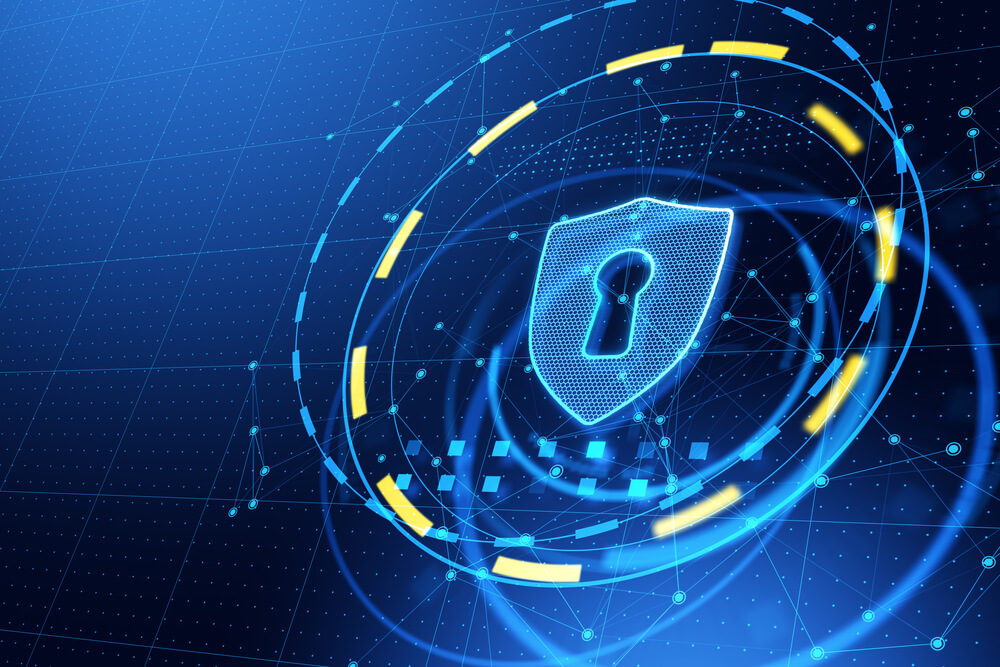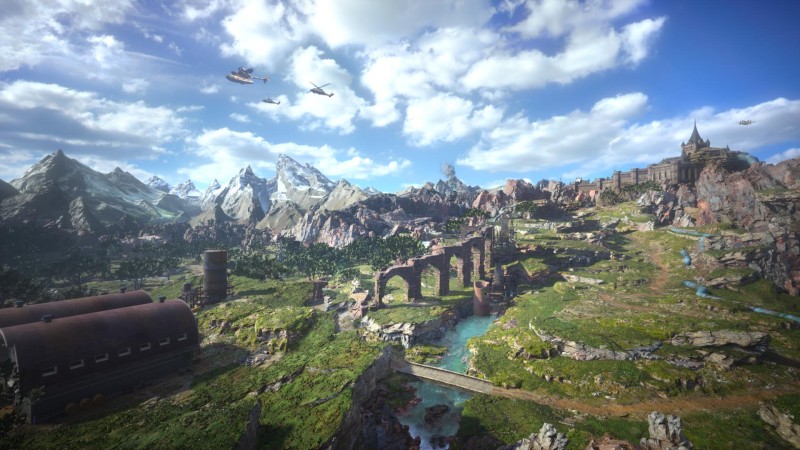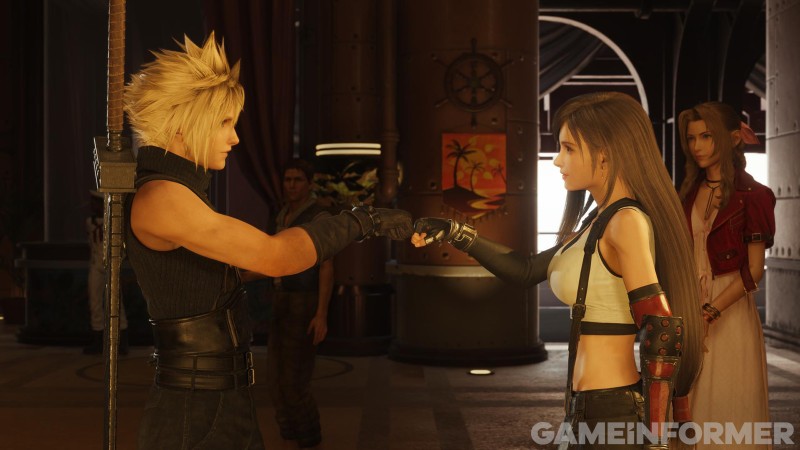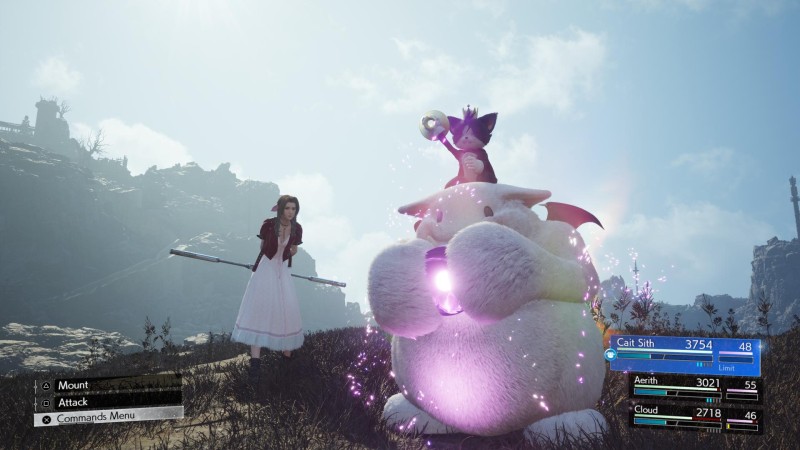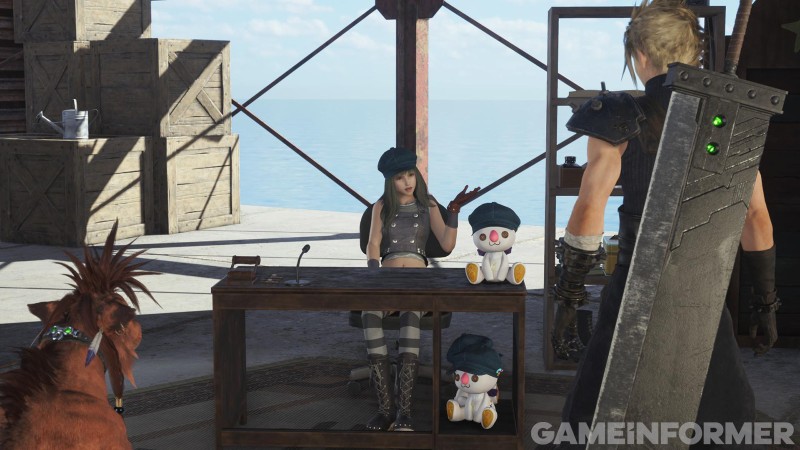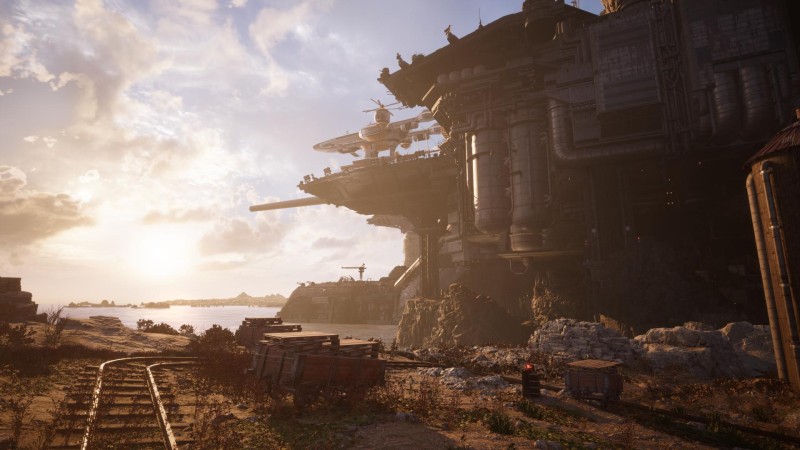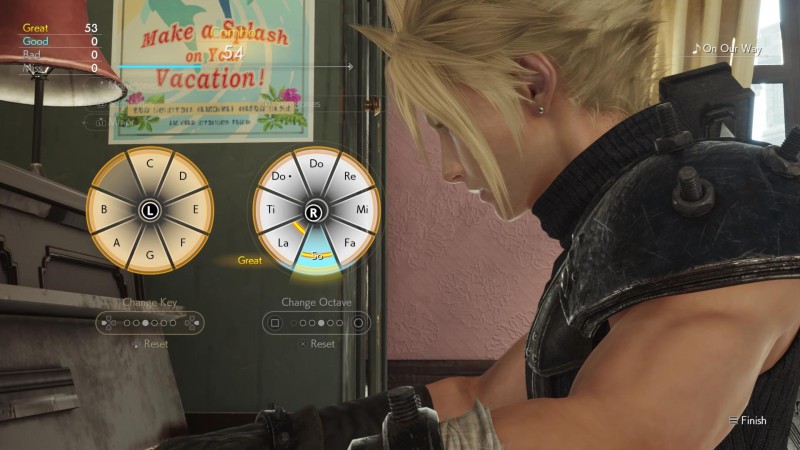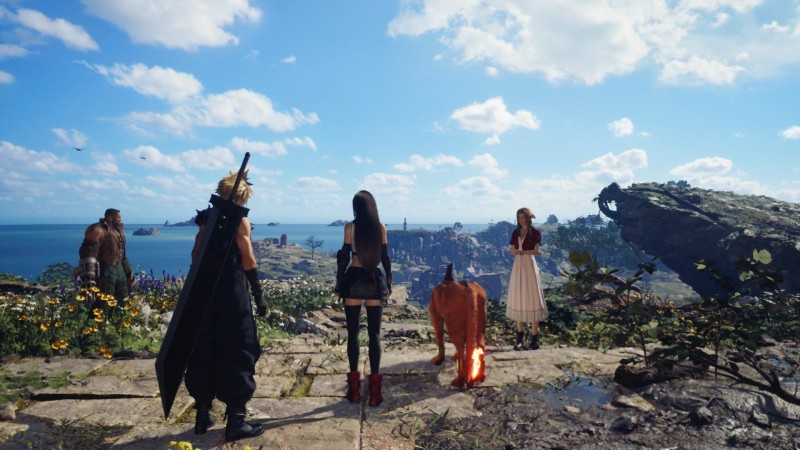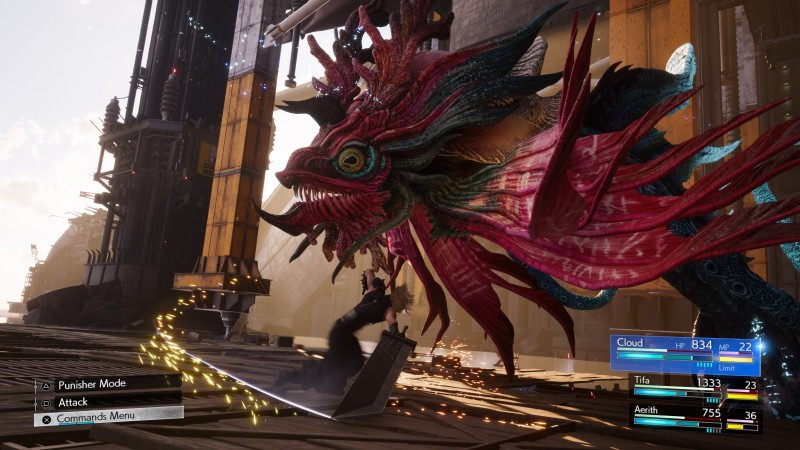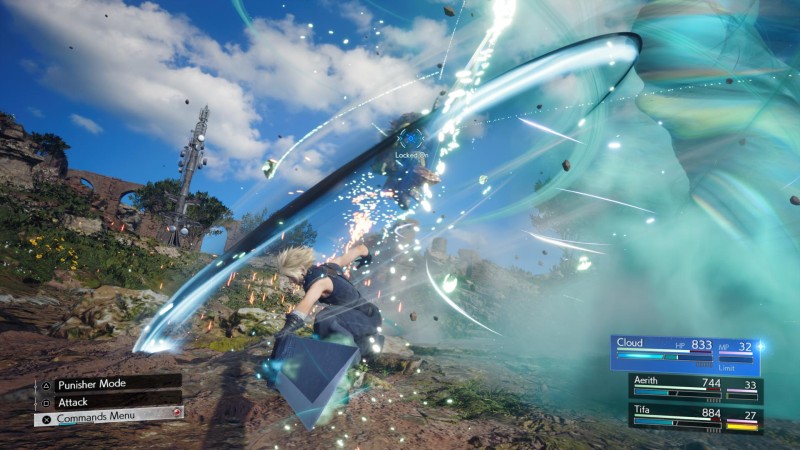Following the events of 2020’s Final Fantasy VII Remake, Cloud, Tifa, Aerith, Barret, and Red XIII have escaped the confines of Midgar and gotten rid of the Whispers, meaning the possibilities as they step out into the vast world depicted in the middle portion of the original Final Fantasy VII are endless. In contrast to the corridor-heavy structure of Remake, the openness of Rebirth is immediately refreshing, but as I found out during both my hands-on and hands-off demos, the improvements don’t even come close to stopping there.
Exclusive Demo
The exclusive portion of my demo – the hands-off part – takes place in the Junon region approximately 10 hours into the main story. The area is mostly made of grasslands but features some mountainous areas with cliffs as well. Driving this hands-off demo is director Naoki Hamaguchi. He pulls up the world map to show just how massive the explorable area of Final Fantasy VII Rebirth is.
While each section of each region – in this case, Grasslands and Junon – is labeled on the map as separate areas, you can seamlessly walk between them. “We thought that it would be easier for players to go to just one region, and so from a U.I. perspective, we have it separated – Junon and Grasslands – but in actuality, you can traverse, and they’re all connected with each other,” Hamaguchi says.
In this demo, Hamaguchi shows me the Crow’s Nest, a new town not present in the original Final Fantasy VII. This sister town to Under Junon shares the same anti-Shinra sentiment and serves as a hub for sidequests and, as I soon find out, minigames.
“In Rebirth, we’ve added these types of cities like the Crow’s Nest – totally new cities that did not exist in the original to go deeper and create this whole worldview of Rebirth,” Hamaguchi says. “We reach this area after completing a quest, and then this place unlocks. The residents already know Cloud and the party are a part of Avalanche.”
Sidequests play a huge role in Final Fantasy VII Rebirth, but naturally, players will need to make the conscious decision to take them on. Making players seek this side content out was a mission the development team took on. “Part of our game design that we took on for Rebirth is that in the main storyline, you’ll be saving Yuffie and Under Junon, and then from there, going towards Junon, and then go forward towards Costa del Sol,” Hamaguchi says. “But for example, hearing the stories of the anti-Shinra people living in Under Junon, you could then feel like, ‘What about this Crow’s Nest area that I’m hearing about? Maybe I want to go over there and explore and go into a side adventure on my own to save people.’ We want the player to be able to make these different adventures and go on their own journeys according to their interests.”
Before diving into the minigame diversions, we decide to take on a sidequest. After talking to an NPC, we learn that there’s a mercenary working out of a nearby lighthouse. During this conversation, we have a choice of what to say in response; I can ask for more information about the merc, ask about the lighthouse, or just outright agree to take on the task.
Sidequests obviously give you plenty of additional opportunities to learn about the world and its denizens, but one of their primary functions in Rebirth is to expand on the relationships between the characters. Sidequests feature specific secondary protagonists alongside Cloud; completing the quest will deepen and expand the relationship between Cloud and that character. For this quest, Red XIII is the secondary protagonist.
Making our way to the lighthouse, we encounter a group of enemies. Using a party of Cloud, Tifa, and new party member Cait Sith, Hamaguchi takes the fight to them. Cait Sith’s battle system might be the most unique of any character in the game. Keeping in line with his original system in the PS1 title, Cait Sith uses a lot of luck-based mechanics. He can also summon a Moogle to change his battle style, but some moves can only be pulled off solo, so even while the Moogle is summoned, Cait Sith can dismount and perform those moves, with the Moogle continuing to attack as an A.I. party member. The Moogle has its own HP, which is shown next to Cait Sith’s as a circle; if the Moogle loses all its HP, it will vanish, and Cait Sith will need to summon another.
While in the original Final Fantasy VII, players would need to find a way around the mountains, Cloud is nimbler in Rebirth, as evident by his ability to climb up and down the various short cliffs and ledges in this area of the map. Additionally, some chocobos have the ability to scale tall walls or glide around to give the party even more traversal options. With Fort Condor serving as the backdrop, Cloud scales down the steep hillside to get close to the abandoned lighthouse.
As they approach the lighthouse, they’re greeted by Kyrie, a woman who first appeared in the Final Fantasy VII novel The Kids Are Alright: A Turks Side Story, but has since appeared in Final Fantasy VII Remake. In Rebirth, she pops up in different regions across the world as her story develops. She’s trying to get her mercenary business off the ground, but no customers have come by yet. It turns out the theme song she’s blasting outside her place of business is attracting monsters and scaring away any potential clients. Naturally, she asks Cloud, Red XIII, and the rest of the party to take care of them, but not before she begs Red XIII to become her pet. Red XIII takes exception to this request, but the party decides to help her with her fiend problem anyway.
The fight starts off easy enough, with Flans stepping up to face the party. These baddies would be annoying enough on their own, but in this quest, Kyrie taunts you as you take them on. Cait Sith and his Moogle use a Moogle Mine ability, scattering mines across the battlefield and dealing a good amount of damage to several of them.
Eventually, the Flans are all defeated, but before the party can breathe a sigh of relief, the threat escalates to White Mousses. These massive enemies pose a much bigger threat, so Hamaguchi decides to call in backup in the form of Titan, one of Rebirth’s summons. The giant beast, acquired through Chadley’s questline, wails on the White Mousses, but Cloud isn’t content with sitting on the sideline. Using Cloud’s Synergy Ability with Cait Sith, I witness a very silly sequence where Cloud mounts the Moogle, the Moogle grabs Cloud’s Buster Sword, and the duo attacks the nearby White Mousse for massive damage. Soon thereafter, the final White Mousse falls, and the mission is completed. Kyrie comes down and thanks the party for their help and makes one more plea to Red XIII to let her make him a pet. As she runs off to her next post, Red XIII looks to Cloud and says, “I wouldn’t wish her on my worst enemy.”
With the main thing Hamaguchi wanted to show me behind us, we’re nearing the end of this portion of the demo. However, he wants to give me an idea of what to expect with one of his favorite sidequests. Back at the Crow’s Nest, Hamaguchi guides Cloud and the party in the direction of a piano, but on the way, he walks past a man talking about a card game. While Hamaguchi remains tight-lipped about the mechanics, in talking with the team, I learn that it’s a strategic card game that Cloud will be able to compete in across the region. Different NPCs provide varying degrees of challenge to players, but the team hopes players will enjoy the deck-building aspect of this minigame.
We eventually arrive at the piano. Through exploration, Cloud can find sheet music for compositions within the Final Fantasy VII world. He can then sit at a piano and play the music. This rhythm-based minigame has you use the analog sticks to play the required notes, plus some of the buttons to change octaves and keys. It looks extremely intricate in its highest form, but that’s nothing compared to what Hamaguchi shows me next, as he goes to freeplay mode, where players can play whatever they want on the piano using the in-game mechanics. He then pulls up a video showing a developer playing a popular Japanese song on the piano, complete with a video of her hands. Watching her hands fly around the DualSense controller is a sight to behold, but I can’t help but think that once Final Fantasy VII Rebirth is available, players will embrace these mechanics to show off their skills. The team is hopeful to spawn a whole community of the best in-game pianists recreating their favorite songs and posting them online.
With that, my hands-off demo came to an end, and thankfully, I also got to hold the controller and play a little myself. It wasn’t an exclusive sequence, but it did give me a sense of how the combat and exploration feel in Final Fantasy VII Rebirth.
Hands-On
Hands-On Preview
My hands-on time with Final Fantasy VII Rebirth consists of sequences discussed in Marcus Stewart’s preview. The first sequence features the flashback mission from Mt. Nibel, while the second is exploration-based in an open area of Junon with a boss battle at the end. Fans of the original remember this expedition through the Nibelheim caves well, particularly due to how powerful it feels to play as Sephiroth. While he doesn’t feel quite as overpowered in Rebirth as he did in the original, the strength he wields is still a sight to behold. I loved using Sephiroth and Cloud together to perform special Synergy Abilities. Each character pairing in the game has a different one, and that includes Cloud and Sephiroth in this fated mission.
Slashing through the enemies in the caves is fun and simple enough; the combat system from Remake has been refined, and it feels great in action. I love using the action-based moves to fill the ATB gauge, which in turn fills the Synergy Ability gauge. It all plays into a seamless combat ecosystem, and I love how fluid it all feels in real-time. After solving a brief environmental puzzle involving vacuuming gases out of the room, I come to a boss battle with a Materia Guardian. This engaging fight lets me strategize a bit more with the one-two punch that is Cloud and Sephiroth, using a combination of standard attacks, character abilities, Limit Breaks, magic spells, and Synergy Abilities – not to mention different stances characters can now take. The list of options is immense, but the combat still somehow feels streamlined and approachable. After the duo knocks the Materia Guardian off the ceiling and launches an all-out assault on it, this portion of the demo ends.
The next area picks up in the open wilds of Junon, west of where the hands-off demo happened. I can go straight to the boss battle in the town of Under Junon or explore a little bit of the open map. No surprise, I decide to take my time and see what the area has to offer. I press R1 to call chocobos for my party – seeing Red XIII mounted on a chocobo will never get old. I appreciate how much easier it seems to be to get a chocobo in Rebirth than it was in the original game. As I explore, I come across some foes. Using the team of Cloud, Aerith, and Red XIII, I take down a bunch of enemies. Red XIII’s combat style relies on using the guard mechanic and filling his Vengeance Gauge, which allows him to temporarily boost his attack power and dodge speed.
As I explore, I partake in World Intel missions, which are given to me by Chadley. The missions outside Under Junon involve researching and defeating particular types of monsters in the area, which spawn once I get to a specified spot on the map. Taking down Orcs, Grassland Wolves, and other enemies out in the Junon region before time expires helps progress the sidequest.
The end of my demo draws near, so I decide to make a beeline toward the boss battle within the limits of Under Junon. Instead of involving Priscilla and her dolphin like in the original, the Terror of the Deep boss battle (previously known as Bottomswell) serves as the team’s introduction to Yuffie. The fight itself plays out similarly to the original version of the battle; the monster progresses through a few forms and sequences, including some where he annoyingly traps some of your allies in water orbs. Thankfully, the orbs are easier to eliminate this time, as they seem to only require one spell to take out.
After the most drawn-out battle of my hands-on demo, including a flashy Synergy Ability with Cloud and Aerith called Firework Blade, I vanquish the Terror of the Deep, and my demo comes to an end. I assume that as the story progresses, I’ll have some dolphin-related traversal in my party’s near future, but for now, it’s time to relinquish the controller.
After what I saw and played, I simply cannot wait to lose hours upon hours in Final Fantasy VII Rebirth. As someone who loves Remake, continuing the story of Cloud and his friends is immediately appealing, but it’s the more open nature of this game that is calling my name. In fact, according to Hamaguchi, side content makes up about 80 percent of the exploration-based content, but even just focusing on the main storyline, players can still expect about 40 hours of gameplay. Meanwhile, those who do a good amount of side content should expect approximately a 60-hour playthrough, while the most dedicated sidequesters could top the 100-hour mark for their save file.
Final Fantasy VII Rebirth arrives on PlayStation 5 on February 29. For more, be sure to check out our exclusive coverage hub by clicking the banner below. For a more detailed breakdown of the hands-on demo, be sure to check out Marcus Stewart’s rundown of his time with Rebirth here.
